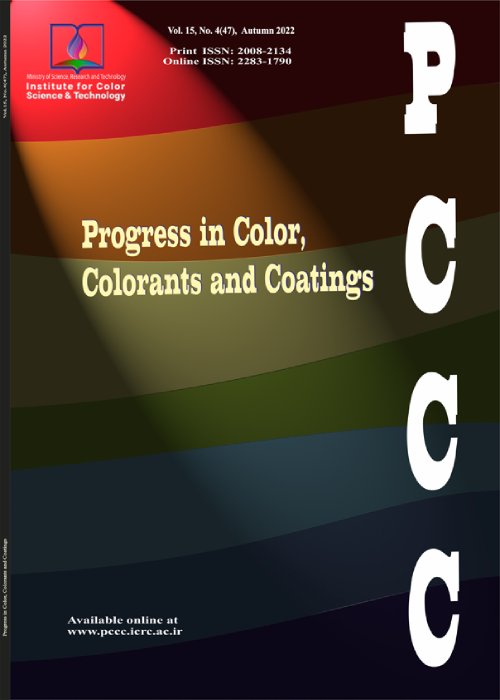فهرست مطالب
Progress in Color, Colorants and Coatings
Volume:5 Issue: 1, Winter 2012
- تاریخ انتشار: 1391/02/20
- تعداد عناوین: 7
-
-
Page 1Polymorphism is difined as different crystalline phases with the same chemical structure. Diketopyrrolopyrrole (DPP) derivatives, as the innovative heterocyclic pigments, follow this pattern and most of times exist in two crystalline forms of alpha and beta with various application in different industries. Herein, synthesis of 3, 6-Bis (4-chlorophenyl) -2, 5- dihydropyrrolo [3,4-c] pyrrole-1,4-dione called Pigment Red 254 (PR 254) with selected crystalline phase using ionic liquids was achieved without any further need to conventional methods for crystalline phase separation after synthesis. Observed different physical properties such as melting points and color properties of the obtained pigment (PR 254 in / and 0 crystalline phases) are clarified.
-
Page 7A pplications of mica-based pearlescent pigments are related to plastics, cosmetics, automobiles coatings among others, but they seem to be not explored by the ceramic industry. In this work, intensively red and gold colored muscovite pigments covered with layer of nanoparticles containing iron and zirconium oxides were prepared by homogeneous precipitation. The final color was obtained after thermal annealing. The pigments were characterized by X-ray diffraction, scanning electron microscopy and X-ray fluorescence as well as measuring colorimetric parameters of the obtained ceramic materials. Results indicated that nanoparticles are formed on muscovite flakes and the red factor increases with iron content.
-
Page 15The effect of UV/Ozone irradiation together with the pretreatments using distilled water, hydrogen peroxide, and hydrogen peroxide/sodium silicate solutions on the dyeing depth of the poly(lactic acid), PLA, and poly(ethylene terephthalate), PET, fabrics by the application of disperse dyes were investigated and the results were compared with that of untreated fabrics. The results showed that the reflectance and the L* of the treated fabrics decreased and these reductions maximized by the pretreatment of the fabrics with the hydrogen peroxide/sodium silicate solution. The SEM images of the fabrics showed a change in the surface morphology of the treated fabrics which is attributed to the intensified etching effect of the UV/Ozone irradiation.
-
Page 23The reaction of some carbocyclic and heterocyclic Schiff bases with the synthesized 1-bromo, 4-[4-(4-nitrophenylazo) phenoxy] butane and formation of novel linear azo-azomethine compounds in good to excellent yields were investigated. The compounds were fully characterized by UV-Vis, FT-IR, 1H NMR spectroscopic techniques and elemental analysis. Effects of various solvents on their visible absorption spectra at a concentration of 10-5-10-6 M were estimated. The color of the dyes is discussed with respect to the substituent therein. Introduction of an electron-withdrawing group into the para-position of azomethines produces bathochromic shift of the absorption peak in all solvents. The key features of these reactions are, in turn, their operational simplicity, mild reaction conditions and easily-accessed starting materials.
-
Page 35Nanoscale zero-valent iron (NZVI) particles were synthesized by the aqueous phase borohydride reduction method, and the synthesized NZVI particles were used for the degradation of Basic Yellow 28 (BY28) dye in aqueous solution. The influence of experimental variables such as reaction time, NZVI particle dosage and pH were studied on the decolorization of BY28. Mixing an aqueous solution of 100 mg L−1 BY28 with 2 g L-1 Fe0 resulted in 98.2% loss of BY28 within 15 min. The color removal efficiency was found to be increased with decrease in initial pH of dye solution and NZVI exhibited good color removal efficiency at acidic pH. Solvent extraction of the Fe0 revealed that BY28 removal was not through adsorption, but through degradation, as Fe0 treatment of BY28 lead to new chromatographic peaks (degradation products) in HPLC analysis.
-
Page 41This study examined the photolytic degradation of C.I. Acid Red 73(AR73), in aqueous solution by KMnO4/UV/H2O2 process. A continuous circulated photoreactor equipped with a UV lamp was used. (I) Potassium permanganate was used for decolourisation of AR73 dye solution. The stoichiometric amount of potassium permanganate required for 1 mol of AR73 complete color removal was determined (2.79 mol). In the acidic solution,100% of AR73 color removal and near 10% dye mineralization have been observed in no more than 5 minutes. (II) After decolourisation period, UV/H2O2 system was applied for mineralization of the dye solution. Under the best operational conditions, after 180 minutes of UV irradiation, 90% of dye mineralization was observed. III) The results of this method were compared with those of obtained by using UV/H2O2 system (without KMnO4). It was found that within the same irradiation time, KMnO4/UV/H2O2 process is about 10% more effective for mineralization of AR73 dye solution.
-
Page 47Nanohydroxyapatite-carbon nanotube nanocomposite coatings were deposited via electrophoretic deposition (EPD). AISI 316L stainless steel and ethanol were used as substrate and dispersing medium, respectively. 5%wt carbon nanotube (CNT) was used as reinforcing phase. Uniform and crack-free coatings were obtained both for HA and HA-5%wt CNT coatings. Scanning electron microscopy (SEM) revealed that most of microcracks in HA coating has eliminated after introducing CNT as reinforcing phase. The variation of deposit weight by time and voltage is measured both for HA and HA-5%wt CNT coatings. Thickness measurements revealed that for both coatings, the thickness increases with deposition voltage. X-ray diffraction patterns indicated that HA has not decomposed after sintering at 850 °C for 2 hr in argon atmosphere.


